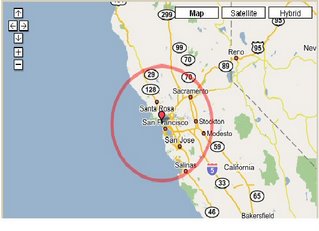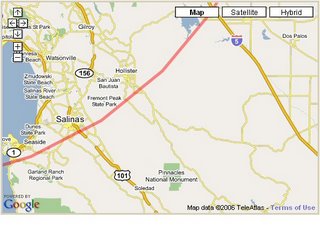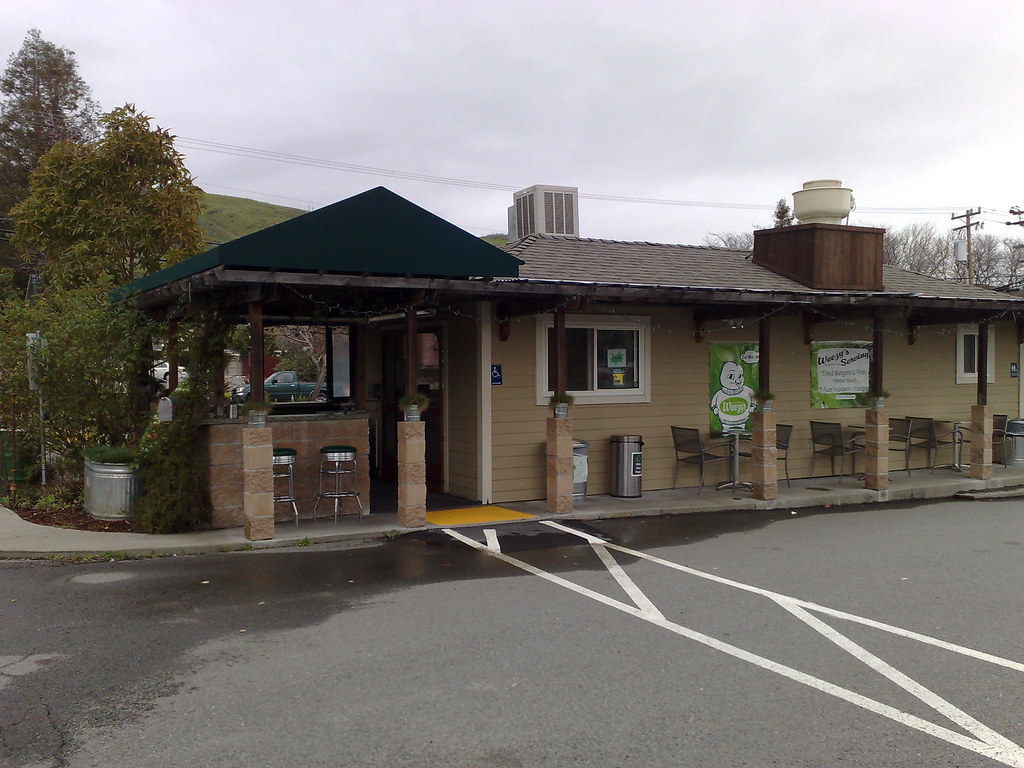Tuesday, February 16, 2010
Inventive and delightful
Weezy's Grass Fed Shed has been on my mind for some time since its opening (and before). Located near Scotty's Market in San Rafael's Terra Linda district, it was just enough out of the way that my visit was delayed. I was happy to find a slice of time to get there and try this wonderful well thought out concept - grass fed beef and veggie burgers served in and with compostable containers, napkins, etc.
I was greeted warmly, and ordered a couple burgers. The sizes are small so you can try a variety of toppings. These are just the perfect size for kids. I got a budget-wise combo that included either regular or sweet potato fries, or a mix. I chose the mix, and got a free sample of their dip for the sweet potato fries too. The dip was really great - creamy (cream cheese based?) with a hint of seasonings. No less so the burgers. The vegetarian moo-less burgers were very good. These don't have the texture of a hamburger, and the good taste made that aspect very forgettable. There is a small bar of condiments to top your burger, and I loved that the tomatoes were the Roma type, just the right size to top these 1/8 lb. beauties. I also convinced (it was not very hard) the staff to use a garden patty in a Contiki style burger that has Kikkoman Teriyaki sauce and a piece of pineapple adorning it. I enjoyed them both, and am looking forward to going back.
I was also lucky enough to be there at the same time as Weezy's brother. He enlightened me about Weezy and her hope as a mother to create a great community place where kids and the rest can enjoy healthy food quickly in a earth friendly way. She also lives nearby.
Restaurant Inspection Results
Critical: 2
Noncritical: 1
Last inspected: December 22, 2009
Find address/phone number/directions on Anna's Map.
Posted by
Anna Haight
at
12:08 AM
2
comments
![]()
Labels: American, San Rafael, sustainable
Friday, December 15, 2006
 Good Food Gone Bad. Live Science has an enlightening slide show of the top 10 good foods gone bad. If you are reading this, no doubt you already know about most of these, but there may be a couple of surprises.
Good Food Gone Bad. Live Science has an enlightening slide show of the top 10 good foods gone bad. If you are reading this, no doubt you already know about most of these, but there may be a couple of surprises.
And if you haven't caught this article in the Economist - "Voting with your Trolley" it's definitely thought-provoking.
For further reading, Sustainable Table is a good place to find out more about voting with your forks.
Posted by
Anna Haight
at
7:19 AM
0
comments
![]()
Labels: sustainable
Saturday, November 25, 2006

Beyond Organic. I've been following the local sustainable movement for awhile, and although I haven't pledged to eat within 100 miles of my home, I still make an effort to buy local when I can. If you don't go to your local Farmer's Market on a weekly basis, or subscribe to a farm participating as part of CSA , it's a bit difficult to stay within that 100 mile radius. Finding things mostly from California though, is not all that difficult. You can see my 100 mile radius above. However blowing it up a bit, thinking things from Salinas were in may not be the case, as the line ends just south of the urban area, and I think a lot of the farms are south of the town. And naturally Bakersfield is completely out, as is Fresno. The urban area to Citrus Heights is in for Sacramento, and luckily, Stockton is in my circle. I think trying the strict 100-mile radius is an interesting experiment, but wonder how practical it is for people outside of areas like California where there is a long growing season and abundant variety. Even in ancient times, people traded foodstuffs, they just used more ecological means of getting the goods around, such as by sailboat, or waterways, even digging canals.
However blowing it up a bit, thinking things from Salinas were in may not be the case, as the line ends just south of the urban area, and I think a lot of the farms are south of the town. And naturally Bakersfield is completely out, as is Fresno. The urban area to Citrus Heights is in for Sacramento, and luckily, Stockton is in my circle. I think trying the strict 100-mile radius is an interesting experiment, but wonder how practical it is for people outside of areas like California where there is a long growing season and abundant variety. Even in ancient times, people traded foodstuffs, they just used more ecological means of getting the goods around, such as by sailboat, or waterways, even digging canals.
The items below are foods which California is the #1 producer of in the US. California's percentage of the total U.S. crop are shown after the item.
Olives - 100%
Almonds - 99%
Walnuts - 99%
Figs - 98%
Kiwis - 97%
Pistachios - 96%
Apricots - 95%
Celery - 94%
Tomatoes - 94%
Broccoli - 93%
Plums - 93%
Nectarines - 93%
Strawberries 90%
Carrots - 89%
Lemons - 89%
Grapes - 88%
Garlic - 86%
Avocados - 84%
Dates - 82%
Lettuce - 78%
Peaches - 76%
Honeydew - 73%
Asparagus - 55%
Cantaloupe - 54%
Bell Peppers - 47%
Onions - 27%
Cabbage - 22%
Milk & Cream - 21%
Artichokes - 19%
Honey - 18%
Spinach-18%
If we followed the 100 mile rule across the US - well, at this moment, no one outside a circle very near California would enjoy Olives or Olive oil. I get most of mine in my local circle, from The Olive Press, where local olives are pressed on site. Since it's not available in stores, if I had to make a special trip for it (I pick it up on the way to visit my father in Sonoma), I think the gas I burn would make it a bad ecological proposition. Following the 100 mile plan would necessarily force a diversification of foods where diversification would be possible, but there is a large section of the country where the soil or climatic conditions aren't conducive to this. And the growing season may be short. The fine art of canning would need to be revived, or more regional canners spring up again. Our taste for fresh would have to change, and the health benefits we reap from having more fresh food would also be lost in some areas where year-round produce isn't possible. I'm all for reducing food miles, and using resources more efficiently, and I love local and seasonal, but I think there's a long way to go to make this practical for the masses across the country, and that's where it will have to reach in order to make the most ecological impact.
Posted by
Anna Haight
at
9:59 AM
0
comments
![]()
Labels: organic, sustainable











